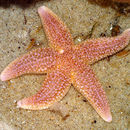en
names in breadcrumbs


Echinoderms were once grouped with cnidarians and ctenophores because of their radial symmetry, but it was later discovered that the radial symmetry of echinoderms is secondarily derived, both during embryological development and evolutionary history. Larval echinoderms are bilaterally symmetrical, while the oldest echinoderm fossils are neither radial nor bilateral. (Pearse, et al 1987)
US Federal List: no special status
CITES: no special status
The Asterias rubens does not adversely affect humans, except through competition for shellfish.
The Asterias rubens contributes no important benefits to humans.
Asterias rubens feed mainly upon molluscs, especially bivalves and snails. In addition, they act as scavengers on any dead animals they encounter. Like all sea stars, the stomach of the Asterias rubens turns inside out through the mouth and slips into the shell of the prey. Next, digestive enzymes enter the prey along with the everted stomach lining to further aid in digestion. The sea star also may use its tube feet to pry open a bivalve. (Pearse, et al 1987)
Studies have monitored the predation of the Asterias rubens upon sea scallops, Placopecten magellanicus. The experiments were designed to test the importance of prey size and vulnerability of the sea scallops to the sea stars. The Asterias rubens preferred small- to medium-sized scallops, based on the sea star's ability to slowly sneak upon the prey. When doing so, predatory sea stars emit saponins to which scallops and other prey species detect and use against the predator to monitor the distance between the two. This allows the scallop time to protect itself from the hungry predator by assuming the ready-to-swim position. Crabs and other fish have the advantage of agility compared to the slow creeping sea stars, allowing these quicker organisms better food selection, or in other words, larger scallops. (Barbeau and Scheibling 1994b, Barbeau, et al 1996).
Studies of the effect of temperature upon predation rates by sea stars concluded that the effectiveness of sea scallops' escape response decreases with increasing temperature, resulting in a higher success rate for the sea star. (Barbeau and Scheibling 1994a)
The Asterias rubens settles in the Northern Atlantic region on rocky, temperate shores. Most sea stars, including the Asterias rubens, may live in a variety of depths, including shallow shores to up to 200 fathoms. (Pearse, et al 1987; Bullough 1950)
Biogeographic Regions: atlantic ocean (Native )
Settlement of the Asterias rubens occurs along the rocky shores of the Atlantic Ocean. Studies performed along the coast of Nova Scotia show the tendency of these starfish to be found in kelp beds; they were the only echinoderms found on the kelp fronds. Further studies have shown that the population density of the Asterias rubens is correlated with subtidal blue mussel, Mytilus edulis, beds. These Mytilus edulis beds are short-lived due to intense predation; therefore, this influences the location of the Asterias rubens. (Barbeau, et al 1996)
Aquatic Biomes: coastal
The body consists of a central disk from which five arms radiate outward. The arms are not sharply marked off from the central disk. Sea stars have no designated head, and the mouth is in the center of the disk on the lower side of the sea star. The Asterias rubens may be a variety of colors including red, purple, and orange. Asterias rubens are measured anywhere from 5mm in armlength diameter to 150mm in diameter. (Bullough 1950)
Other Physical Features: ectothermic
The breeding season of the Asterias rubens occurs in the spring. A sea star is sexually mature after one year of development. Sea stars may reproduce sexally or asexually. Asexual reproduction involves division of the disk and regeneration of each half. Sexual reproduction involves the production of sperm and eggs by separate female and male sea stars. Fertilization occurs outside the individuals in the seawater.
During embryo development, the Asterias rubens forms a blastula, which in three days forms the larva with structures such as the gut, anus, and coelom.
Populations of Asterias rubens have been found to be infected with the ciliate Orchitophrya stellarum. This parasite infects only male sea stars causing a variety of damage, including mechanical damage to the gonads, alteration in the host's hormonal pattern, and direct consumption of gonadal tissues. This decreases the reproductive potential of a population and may reduce the proportion of males to females. Fortunately, the decline in the number of males within a population, increases the likelihood of larvae survivorship because of increased food availability. (Bullough 1950; Pearse, et al 1987; Borradaile and Potts 1963)